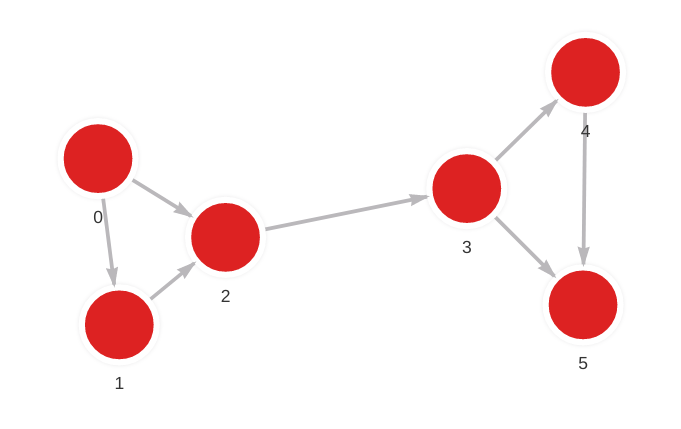community_detection_online
This query module implements the LabelRankT dynamic community detection algorithm.
LabelRankT belongs to the label propagation family of community detection algorithms and thus rests upon the idea that individual nodes learn from their neighbors what community they belong to.
Being dynamic and efficient, the algorithm is suitable for large-scale graphs. It runs in O(m) time and guarantees O(mn) space complexity, where m and n are the counts of vertices and edges in the graph, respectively.
Dynamic algorithms such as LabelRankT are especially suited for graph streaming solutions such as Memgraph. As updates arrive in a stream, it avoids redundant work by only processing the portion of the graph modified by the update.
Furthermore, the algorithm improves upon earlier label propagation methods by being deterministic; its results are replicable. Taking into account edge weight and directedness generally yields better community quality than similar methods, and it extends LabelRankT’s compatibility to a wider set of graphs.
1 LabelRankT: Incremental Community Detection in Dynamic Networks via Label Propagation, Xie, Jierui et al.
| Trait | Value |
|---|---|
| Module type | algorithm |
| Implementation | C++ |
| Graph direction | directed / undirected |
| Edge weights | weighted / unweighted |
| Parallelism | sequential |
Procedures
If you want to execute this algorithm on graph projections, subgraphs or portions of the graph, be sure to check out the guide on How to run a MAGE module on subgraphs.
set(directed, weighted, similarity_threshold, exponent, min_value, weight_property, w_selfloop, max_iterations, max_updates)
Performs dynamic community detection using the LabelRankT algorithm.
The default values of the similarity_threshold, exponent and min_value
parameters are not universally applicable, and the actual values should be
determined experimentally. This is especially pertinent to setting the
min_value parameter. For example, with the default 1/10 value, vertices
of degree greater than 10 are at risk of not being assigned to any community and
the user should check if that is indeed the case.
Input:
directed: boolean (default=False)➡ Specifies whether the graph is directed. If not set, the graph is treated as undirected.weighted: boolean (default=False)➡ Specifies whether the graph is weighted. If not set, the graph is considered unweighted.similarity_threshold: double (default=0.7)➡ Maximum similarity between node’s and its neighbors’ communities for the node to be updated in the ongoing iteration.exponent: double (default=4)➡ Power which community probability vectors are raised elementwise to.min_value: double (default=0.1)➡ Smallest community probability that is not pruned between iterations.weight_property: string (default="weight")For directed graphs, the values at the given edge property are used as weights in the community detection algorithm.w_selfloop: double (default=1)➡ Each vertex has a self-loop added to smooth the label propagation. This parameter specifies the weight assigned to the self-loops. If the graph is unweighted, this value is ignored.
max_iterations: integer (default=100)➡ Maximum number of iterations to run.max_updates: integer (default=5)➡ Maximum number of updates to any node’s community probabilities.
Output:
node: Vertex➡ Graph node.community_id: integer➡ Community ID. If the node is not associated with any community, defaults to -1.
Usage:
CALL community_detection_online.set(False, False, 0.7, 4.0, 0.1, "weight", 1, 100, 5)
YIELD node, community_id;
get()
Returns the latest previously calculated community detection results. If there
are none, defaults to calling set() with default parameters.
Output:
node: Vertex➡ Graph node.community_id: integer➡ Community ID. Defaults to -1 if the node does not belong to any community.
Usage:
CALL community_detection_online.get()
YIELD node, community_id;
update(createdVertices, createdEdges, updatedVertices, updatedEdges, deletedVertices, deletedEdges)
Dynamically updates previously calculated community detection results based on changes applied in the latest graph update and returns the results.
Input:
createdVertices: mgp.List[mgp.Vertex]➡ Vertices created in the latest graph update.createdEdges: mgp.List[mgp.Edge]➡ Edges created in the latest graph update.updatedVertices: mgp.List[mgp.Vertex]➡ Vertices updated in the latest graph update.updatedEdges: mgp.List[mgp.Edge]➡ Edges updated in the latest graph update.deletedVertices: mgp.List[mgp.Vertex]➡ Vertices deleted in the latest graph update.deletedEdges: mgp.List[mgp.Edge]➡ Edges deleted in the latest graph update.
Output:
node: Vertex➡ Graph node.community_id: integer➡ Community ID. If the node is not associated with any community, defaults to -1.
Usage:
As there are a total of six complex obligatory parameters, setting the parameters by hand might be cumbersome. The recommended use of this method is to call it within a trigger, making sure beforehand that all predefined variables are available:
CREATE TRIGGER sample_trigger BEFORE COMMIT
EXECUTE CALL community_detection_online.update(createdVertices, createdEdges, updatedVertices, updatedEdges, deletedVertices, deletedEdges) YIELD node, community_id;
Communities calculated by update() are also accessible by subsequently calling
get():
CREATE TRIGGER sample_trigger BEFORE COMMIT
EXECUTE CALL community_detection_online.update(createdVertices, createdEdges, updatedVertices, updatedEdges, deletedVertices, deletedEdges) YIELD *;
CALL community_detection_online.get()
YIELD node, community_id
RETURN node.id AS node_id, community_id
ORDER BY node_id;
reset()
Resets the algorithm to its initial state.
Output:
message: string➡ Reports whether the algorithm was successfully reset.
Usage:
CALL community_detection_online.reset() YIELD message;
Example
- Step 1: Input graph
- Step 2: Set trigger
- Step 3: Load commands
- Step 4: Running command
- Step 5: Results

CREATE TRIGGER community_detection_online_trigger BEFORE COMMIT
EXECUTE CALL community_detection_online.update(createdVertices, createdEdges, updatedVertices, updatedEdges, deletedVertices, deletedEdges) YIELD node, community_id
SET node.community_id = community_id;
MERGE (a: Node {id: 0}) MERGE (b: Node {id: 1}) CREATE (a)-[r: Relation]->(b);
MERGE (a: Node {id: 0}) MERGE (b: Node {id: 2}) CREATE (a)-[r: Relation]->(b);
MERGE (a: Node {id: 1}) MERGE (b: Node {id: 2}) CREATE (a)-[r: Relation]->(b);
MERGE (a: Node {id: 2}) MERGE (b: Node {id: 3}) CREATE (a)-[r: Relation]->(b);
MERGE (a: Node {id: 3}) MERGE (b: Node {id: 4}) CREATE (a)-[r: Relation]->(b);
MERGE (a: Node {id: 3}) MERGE (b: Node {id: 5}) CREATE (a)-[r: Relation]->(b);
MERGE (a: Node {id: 4}) MERGE (b: Node {id: 5}) CREATE (a)-[r: Relation]->(b);
CALL community_detection_online.get()
YIELD node, community_id
RETURN node.id AS node_id, community_id
ORDER BY node_id;
+-------------------------+-------------------------+
| node_id | community_id |
+-------------------------+-------------------------+
| 0 | 1 |
| 1 | 1 |
| 2 | 1 |
| 3 | 2 |
| 4 | 2 |
| 5 | 2 |
+-------------------------+-------------------------+
